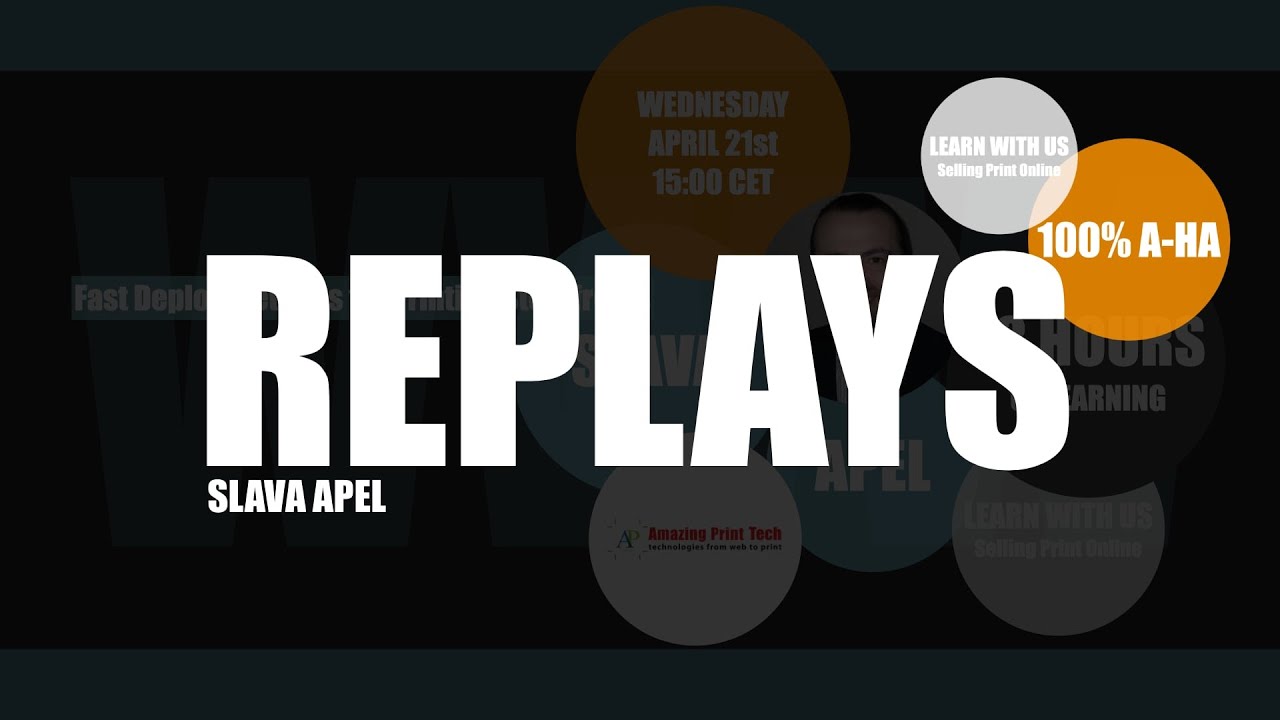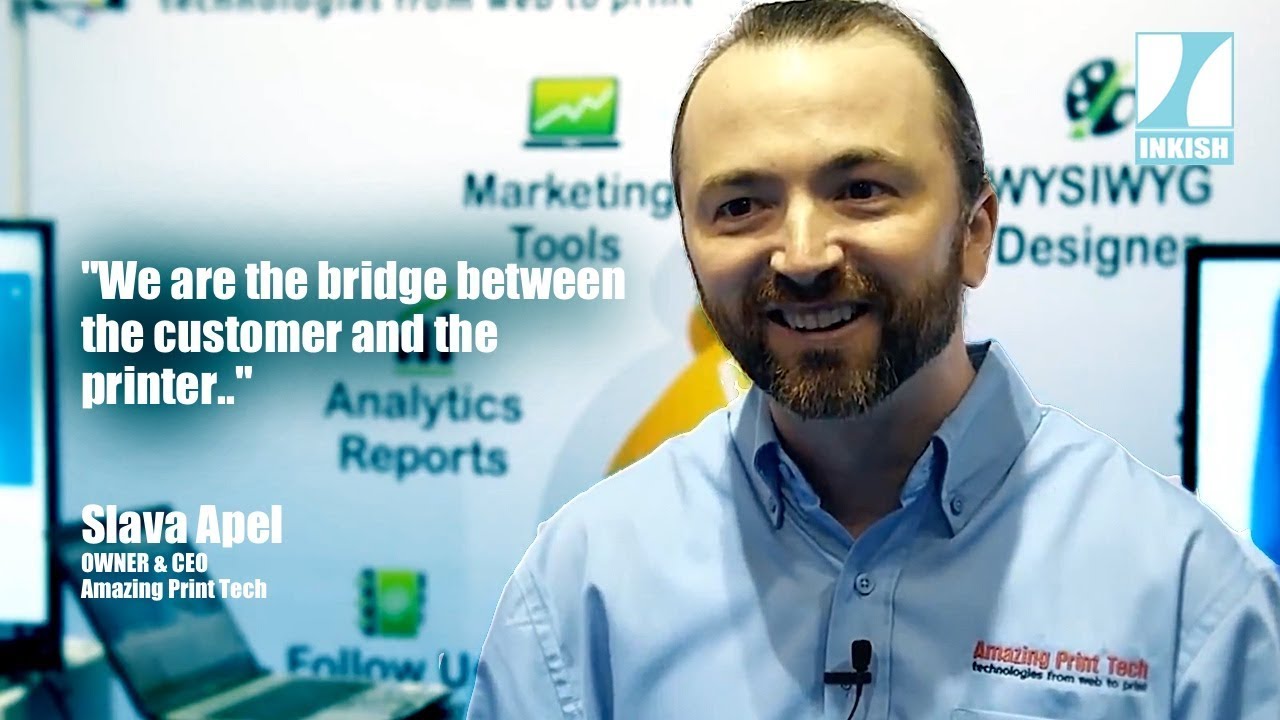CEO Slava Apel from Amazing Print Tech is known for many roles in the printing industry and in this film, you will get an idea about his doings – and there is a lot.
We met him at Print®18 in Chicago where he had at least two roles. One role was as the exhibitor of his award-winning software company Amazing Print Tech, and second as a speaker at one of the educational tracks.
Slava Apel is an author, a speaker, a business developer, a consultant, and a true entrepreneur in the best meaning, and when you listen to his doings, you can’t avoid being impressed. The list of things that he manages to accomplish is amazing. Visiting multiple printing companies. Writing several books. Leading a software company, and from my follow of Slava Apel on LinkedIn, he is also active in his local business community.
Watch, listen, like, and of course, share.
All right, what do I do? That’s a pretty long list. I’ll start off, I’ve been in the print industry for over 20 years. My name is Slava Apel. I had a lot of interesting experiences. I started off from the agency side. I moved to the software side. I transitioned into the marketing side, consultancy side. So there’s many different aspects to what I do.
I’ve done a lot of things that I would say I’m personally proud. I have co-written a book with Dr. Joe Webb on the state of cloud, on the state of cloud production for the print industry. We’re doing a lot of seminars and a lot of training around that area.
I have co-written a book with one of the industry giants when it comes to sales training, which is Dave Fellman. We wrote a book called, Print Sales and Marketing. And in that book we’re educating printers how do you actually make more money doing what you’re doing?
It actually was a very interesting challenge, especially with Dave Fellman. He’s amazing when it comes to face-to-face print sales. Now I’ve done print sales face-to-face in the past, long, long ago. But I’m nowhere as good as Dave Fellman when it comes to training that. However, I’m the best trainer when it comes to teaching you online marketing. Anything from email marketing, social media automation, search engine optimization, pay-per-click marketing. Many aspects that Dave Fellman doesn’t teach.
So we divided the book between offline marketing and online marketing. And that’s where the collaboration worked very well. So if somebody wants to train their sales staff, great, Dave Fellman is there and he has the right chapters for it. If somebody wants to escalate their online sales, well that’s where my portion comes in and I’m teaching them the aspects of online marketing.
Well, I would say in the rising tide, every ship is rising, so right now quite a few of the entities that I’m involved with are doing quite well. My software company has been on a growth every single year for the past five years. My corporate training for print industry and for many other industries has been doing very well as well. I teach at two universities. I teach at a college. I teach for a few non-profits, I teach at two city halls. So that’s what I really enjoy, actually sharing and teaching. My consulting is doing very well as well.
Yes to managing, because everything is related. So when I walk into a business, and I’ve personally stepped in into over a thousand print shops, physically at their location. Spend time with them. You never know walking in there what really is stopping them from being very successful. Is it online sales? Is it their sales staff? Is it their website? Is it their knowledge of marketing? So you really don’t know what it is. So by being very well rounded, around knowing every piece of equipment that’s coming out, and knowing every piece of software that’s available to them for automation, understanding every type of marketing, you can actually go in and genuinely help them instead of just trying to sell them something.
So considering that my passion is to help them make more money and be more successful, having many different hats, having a lot of knowledge helps. And the true way to know whether you know something or no, is actually by teaching it. So by teaching that, I know that I can hone in and I can understand much better what I can do to help them.
A lot of money will come in once I do for myself as somebody in the industry. That somebody is the industry expert. I’m the person that somebody can go to, almost like to a therapist, and say, “Here’s my business problems.”
[crosstalk 00:03:37] how it got there.
Right, right. So the psychotherapist. Not a licensed therapist. Yeah, but they can come to me and I can actually help them.
I’ll probably bring in with me an expert for the mental problems. But after visiting so many shops, I would say, one of the years, about seven or eight years ago, I spent time in over 60 airports, flying and meeting with printers, understanding. Now being from anywhere from Dubai to Australia, all over the US-
I am. From South Africa, to UK, pretty much all over US, I had a privilege of so far, well within a couple of months visiting 20 different states in America. So traveling so much-
Well, just a few more, yes. I’m sure I can do that. And in doing so, you do see who’s successful, who is not. What the secrets are to their success. I remember flying to one of the locations taking two small planes just to land there. And the company is doing $30 million out of a tiny town, pretty much employing the entire town for that printing location. Now, I know that their success is not about doing door-to-door sales or having sales people. These are people that are perfect at online marketing.
These are people that are perfect at getting their community to work together with them. These are people that are really good about pricing. So understanding what makes that small company of $30 million, considered to be small, what takes that little company to become an online giant, and it really came from the owner. The owner was really, really good about cheering his employees on, and doing online marketing.
From some of the data that I read, over 2,000 print shops go out of business every single year in US. Now statistically, it may look bleak, but on the flip side of it, close to 2,000 new print shops open up every single year. So there is a little bit of a plateau. And I’m looking at it almost like a forest. You have the old trees that are dying out making space for the new trees and a new growth. That’s the one that’s actually fueling the innovation. So the new shop that’s opening up, they’re not buying the old-style equipment, they’re buying a lot more digital. They’re buying a lot more wide format and inkjet. They’re the ones that are looking for the innovations.
Right. You’re looking at, I would say, half of the thermography business went away. Well nobody prints that thermographic or raised-print business card anymore. Now, the most popular business card is full color. So why should a business that is refusing to change over their equipment while they’re in thermography calling themselves, “Hey, I’m a raised-print business card printer,” be still around? Unless they’re buying the new equipment and reformatting themselves to be a better fit towards their customer, they are going to die out.
There’s no single answer why everybody is going out of business. Stubbornness, could be age, they just wanted to retire, and their business was not positioned well enough to transition to somebody else. It could be that their online competitor is killing them.
Many times that I walk into print shop that is considered to be an analog or face-to-face type of a business. They don’t believe into online sales, and yet, every one of their customers, whenever they phone them ask can they order online. They just refuse to go and become the digital company. Or historically they relied on word of mouth type of marketing. They’ve never hired sales people, they never even turned on their website. There’s a huge number of printers that I’m dealing with that don’t even have a functioning website.
So what is killing them is actually them. So, if the owner decides to hire sales people, turn on great online marketing, enhance their website, empower their customers for convenience and self-service, there is no reason for that owner not to be making money. There is enough money online for every one of the printers to be successful. I remember maybe two years ago, [inaudible 00:07:44] Vista Print did a public statement that only 2% of the marketplace is, that’s their market penetration. So that leaves a lot of online marketplace for everybody else.
I remember reading the prospectus of Vista Print going public. And in there they actually identified who their most feared competitor is. They were listing at that point, in Kinko’s, and Staples, OfficeMax as some of the potential large competitors. But when you read between the lines, and it was said right in there, that a local print shop with online presence, that’s the killer combination.
It’s all about convenience. So if I wanted to buy brochures or business cards, and I wanted them tomorrow, I cannot go to an online shop and waiting for the delivery.
Yes, something that I heard close to 15 years ago from Frank Armada. He said, “Close to 70% of everything that is going to be printed is going to be printed from an online perspective, from a website.” So we were to paraphrase that, and that was many, many years ago, I’m seeing more and more items, everyone walking by the booth, doesn’t matter what they’re printing. From a door hanger to a brochure, to a book to a magazine, there is nothing that I have seen yet that would say, “You know what, we can’t order that online.”
Now, so there’s so much great capacity, that if you don’t digital equipment as of yet, if you don’t have inkjet, you don’t have wide format, you can borrow that capacity from your neighbor until you grow your volumes. And my magic formula for myself is, if you can keep that equipment 70% full, that’s the right time for you to buy it.
If you are buying in anticipation of volumes, in that case, that’s not the right time quite yet. Now, if you marry it with great marketing behind the scenes and you’re purchasing that equipment, then it could be that exclusion from the rule. To say, well if you’re spending tens of thousands of dollars a month, or hundreds to thousands of dollars in marketing, that’s the right time for you to buy it, in anticipation of that volume.
And I’ve seen companies fail at that as well. There’s a great online company that thought they were going to do great with self-inking stamps. They bought all of the equipment. They priced it out based on them being completely full and operating 24/7, trying to produce that self-inking stamp. But by the commercials went out, by the time the marketing started, it wasn’t the case, so they actually lost money for the first little while.
Yes. You can grow the industry. Like we’re seeing today, between Scodix and MGI, great new effects. With the great new effects, you can create new products. There are new products that are coming out all the time. For example, I’ll use a five to 10-year-old example. Sudoku books, where you get to figure out the numbers in the puzzles. Well that really didn’t exist in mass production for a very long time, so that is something that’s new that came to the market, and it’s eating up papers, it’s eating up production.
There are many other examples. For example, self-published books. So I would say, everyone on this floor, there’s a couple of thousand people here, could public a book. Now this did not exist five years ago. You actually had to sign, you had to be famous already. You had to convince a publisher to invest into you. You had to spend time and money creating tens of thousands of pre-orders ahead of the time.
So in the past you had to be already a personality. You had to be already a known author, or you had to know somebody. You had to had a great story in order for you to be a published author. Today with self-publishing anyone can be an author, and there are easy tools for you to produce books in the quantities of one.
So one of the talks that I’m giving at this trade show is the next version of printing industry. When we’re going to be walking into the blockchain-based data management, where there are multiple parties dealing with each other-
You had to mention blockchain.
Oh, of course. Well, blockchain is coming. It’s like, if I was sitting here in early ’70s, and saying, “Internet is coming.” So we are right here right now saying, “Blockchain is coming.” That’s where it’s just going to get easier for you to start dealing with customer data. It’s going to be easier for you to provide proofs that things got delivered. That when the order happened, at what state each of production is. Or even where was this page sourced out, from what tree, on what continent, and using what practices. You want to make sure that there’s no child labor. You want to make sure that the tree got replaced by another tree that got grown, and you can start tracking all of that using blockchain.
Blockchain technology is actually a stepping stone to the next stage, which would be artificial intelligence, which will be decentralized computing, which is very similar to the cloud technologies. So blockchain is just a stepping stone to where we’re going to be.
So it’s like us saying, “Internet is coming, and email is going to be great.” So between blockchain and cryptocurrency, we’re still at the stage of email is the killer app for internet.





























